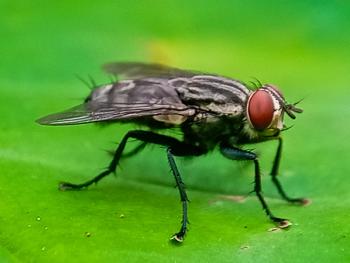
Important protozoal diseases and how to control them (Proceedings)
The latest information on giardiasis, coccidiosis, neosporosis, and trichomoniasis.
Giardiasis
Giardia infections in dogs and cats are caused by Giardia intestinalis (G. lamblia). A number of variants of Giardia exist (called assemblages or genospecies). It now appears that dogs and cats are infected in most cases with isolate-specific Giardia. However, the potential does exist for dogs to harbor isolates infective for humans and vice-versa. The parasite usually resides in the small intestine, although exceptional infections in the lower bowel cannot be ruled out. Giardia is a dimorphic parasite in that it exists as a fragile flagellated binucleate trophozoite and a quadrinucleate cyst. The trophozoite attaches to the surface of epithelial cells in the small intestine; encystment (formation of cysts) occurs in the ileum, cecum or colon. Although the mechanism(s) of Giardia-induced disease remain unknown, evidence suggests that the disease is likely multifactorial involving inhibition of brush border enzymes or other factors such as altered immune responses, nutritional status of the hosts, presence of intercurrent disease agents, and the strain of Giardia involved in the infection. Although many infected animals remain asymptomatic, the most common presenting sign is small bowel diarrhea. Feces are usually semi-formed, but may be liquid. Blood usually is not present. Feces have been described as pale (often gray or light brown), fetid and containing large amounts of fat. Dogs or cats with giardiasis may present with poor body condition, weight loss, and occasional vomiting. As mentioned previously, it is not unusual to find Giardia present with other gastrointestinal diseases such as inflammatory bowel disease. Giardiasis is best diagnosed by fecal flotation using zinc sulfate (specific gravity = 1.18) as the flotation solution (see attached procedure). Centrifugation of the preparation increases the likelihood of recovering cysts. Also, the addition of a small amount of Lugol's iodine to the slide prior to placement of the coverslip containing the concentrated cysts will aid in visualizing the small (10-12 m) cysts. Use of barium sulfate, antidiarrheals or enemas prior to sampling feces may interfere with detection of cysts and should be avoided if possible. Other diagnostic techniques that can be used to recover either trophozoites, cysts, or proteins produced by the parasite include direct examination of feces (wet-mount), immunofluorescent procedures, and ELISA techniques. The recent introduction of a fecal ELISA test for Giardia (Snap® Giardia, Idexx) will assist in ruling out Giardia as a cause of diarrhea in dogs and cats. Much controversy exists surrounding the potential of animal strains of Giardia to infect humans. As mentioned above, it is likely that some host specificity among animal strains of Giardia does exist, I believe that it is best to be conservative about the potential for human infections with animal strains of Giardia. Consequently, it is my view that all animals that are positive by fecal examination should be treated. Several treatment options are available for treatment of Giardia infections in dogs or cats (Table 1). At present, I believe that the use of fenbendazole in dogs should be the first of the agents selected for treatment. Published data also indicates that a combination of pyrantel pamoate, febantel, and praziquantel (Drontal Plus, Bayer Corporation) is also effective against Giardia. Febantel, a prodrug, is metabolized to fenbendazole and oxfendazole once in the host. The activity of Drontal Plus, we believe, results from this endogenous metabolic conversion. Fenbendazole is a safe compound with demonstrated activity against Giardia. Many veterinarians use a 5-day regimen instead of the approved 3-day regimen. Fenbendazole also is effective against other canine intestinal parasites that may be responsible for the observed signs. Another strategy that is gaining popularity in the treatment of giardiasis is the combination of fenbendazole and metronidazole, Although, definitive data is not available regarding use of fenbendazole in cats, it is likely to be effective. Cats can be treated with metronidazole as indicated in Table 1. As noted in table 1, newer available human drugs may be helpful in the treatment of canine or feline giardiasis.
Table 1. Treatment of canine or feline giardiasis*
Coccidiosis
Coccidial infections in dogs and cats are caused by Isospora spp. (also called Cystoisospora). Our recent surveys indicated that about 5% of shelter dogs sampled were passing coccidial oocysts in their feces. The principal agents in the dog are I. canis and I. ohioensis. The principal agents in the cat are I. felis and I. rivolta. These parasites reside in the posterior small intestine and in the large intestine for some species. Their life cycles are generally self-limiting, after which the infection is terminated. The parasites replicate first asexually by schizogony resulting in destruction of many host enterocytes in which they develop. Asexual development is followed by production of gametes that fuse to produce noninfective oocysts that are passed in feces. The developmental cycles in the canine or feline host require 5-9 days depending upon the species. Development to the infective stage (sporulation) requires 1-2 days in the animal's environment. Only sporulated oocysts are infective to susceptible hosts. Clinical signs of coccidiosis include hemorrhagic or mucoid diarrhea, abdominal pain, dehydration, anemia, weight loss and emesis, as well as respiratory and neurologic signs. Death can ensue in extreme cases, particularly in young puppies and kittens. Nursing animals, recently weaned animals, or those that are immunocompromised are more likely to develop clinically apparent infections. There is some indication that stress that results from shipping can lead to outbreaks of coccidiosis in young dogs. It is my belief that clinical coccidiosis in adult animals reflects either underlying concomitant infection and/or immunosuppression. I base this on the self-limiting nature of the life cycle and on research that indicates that experimental reproduction of coccidiosis in adult dogs is difficult following inoculation with sporulated oocysts. Diagnosis of coccidiosis is based on signalment (usually puppies and kittens), clinical signs, and recovery of oocysts in feces. Fecal flotation remains the most practical means of recovering oocysts. A point to remember is that recovery of oocysts alone in feces is not sufficient proof to implicate coccidia as the cause of clinical signs. I have observed coccidial oocysts in the feces of many animals without evidence of intestinal disease. Oocysts of the coccidia mentioned above are round to oblong and measure from 16-51 m long, depending on the species. Oocysts of I. canis and I. felis are large (34-51 m), while those of I. ohioensis and I. rivolta are smaller (16-28 m). Although sulfadimethoxine is the only approved anticoccidial medication for use in dogs or cats, several agents have been used with success (Table 2).Recent research suggests that ponazuril (Marquis, Bayer Healthcare) is effective against coccidia (see Table 2) and has become my treatment of choice. Continuing research will likely provide more definitive data regarding its use in companion animals.
Table 2. Treatment of canine and feline coccidiosis.
Many inquiries about outbreaks of coccidiosis that I have responded to have involved young animals housed in groups such as in kennels or cages maintained by breeders or in pet stores. In most of these situations, treatment with amprolium or ponazuril has resolved the problem. Little can be done to disinfect environments because of the ability of the oocysts to withstand chemicals and adverse environmental conditions. Good sanitation, including prompt removal of feces to prevent development of oocysts to the infective stage and treatment of dams and queens with anticoccidial agents prior to parturition, have been shown to reduce the occurrence of coccidiosis in young animals.
Neosporosis
Neospora caninum is a Toxoplasma gondii-like protozoan that causes neuromuscular disease in dogs and other animals and abortion in dairy cattle. The life cycle involves development of rapidly-dividing tachyzoites in a variety of tissues and organ systems in the intermediate and definitive hosts. As with Toxoplasma, infections in the intermediate hosts terminate with the development of tissue cysts containing bradyzoites. Cysts containing bradyzoites generally are only recovered from the central nervous system. Numerous naturally and experimentally infected intermediate hosts are known including dogs, cattle, sheep and goats, and horses. At present, canids are the only known definitive hosts. Within the canid definitive host, a coccidia-like intestinal phase culminates in the development and passage of nonsporulated oocysts in feces. The small (10-12 ?m) oocysts must sporulate in the environment before they are infective. Natural Neospora infections in cats have not been observed. Clinical neosporosis in dogs is most severe in congenitally-infected puppies. Clinically-affected puppies develop hind limb paresis beginning at about 5 weeks of age. Rapid progression of signs to rear limb paralysis occurs in many infected pups and in some cases results in rigid hyperextension of limbs. Although the cause of hyperextension has not been confirmed, it is thought to be due to both motor neuron dysfunction and myositis. Other observed signs include difficulty in swallowing, paralysis of the jaw, muscle atrophy, and heart failure. The signs often reflect the parasite's predilection for a variety of tissues and organs including the skin. Neosporosis in adult dogs is quite variable and can include encephalomyelitis, polymyositis, myocarditis, and dermatitis. However, neurologic disease is present in most cases of neosporosis in adult dogs. An important epidemiological feature of canine neosporosis is the capability of infected bitches to pass the organisms transplacentally to the developing fetus. Vertical transmission of N. caninum can occur repeatedly from the infected bitch to successive litters. Prevalence of infection in puppies born to infected bitches is extremely variable. All, none, or a portion of puppies may harbor the organism. Among those that acquired N. caninum in utero, generally only a small proportion will develop clinical neosporosis.
Diagnosis of neosporosis is based on the recognition of clinical signs and subsequent serologic confirmation of the presence of N. caninum-specific-IgG antibodies. Several laboratories have developed indirect fluorescent antibody tests for neosporosis and provide diagnostic support for veterinarians. Immunohistochemical tests also are available for the confirmation of infections at necropsy. To date, oocysts of N. caninum have been observed in very few naturally infected dogs. Therefore, the likelihood of confirming Neospora infection by fecal flotation remains small. Treatment of canine neosporosis has been successful with drugs used to treat toxoplasmosis (Table 3). Early diagnosis and rapid initiation of treatment is necessary for successful results.
Table 3. Treatment of canine neosporosis.
Feline Trichomoniasis
There are increasing numbers of reports of large bowel diarrhea in cats concurrent with infection with Tritrichomonasfoetus. A flagellated protozoan bearing some similarity to Giardia. Infected cats present with explosive, fetid diarrhea. Feces are usually foamy, light in color and may contain blood. Many of the affected kittens were purebreds and also suffered from inflammatory bowel disease. Direct examination of feces often revealed uninucleate, flagellated organisms, occasionally in very high numbers. Treatment with enrofloxacin and metronidazole at various dosages and for extended periods of time resulted in improvement of the condition in some, but not all of the cases. Recent use of paromomycin also has achieved some success (Table 4). Although the role of the flagellate in the pathogenesis of the disease is not known with certainty, it should be considered a possible etiologic agent in cases of large bowel diarrhea in cats, particularly when it can be demonstrated by direct examination of feces.
Table 4. Treatment of feline trichomoniasis
Note: Other protozoal disease such as cytauxzoonosis, heptatozoonosis, and cryptosporidiosis are discussed in the notes provided for vector-borne diseases or zoonotic diseases.
References Available On Request
Newsletter
From exam room tips to practice management insights, get trusted veterinary news delivered straight to your inbox—subscribe to dvm360.




